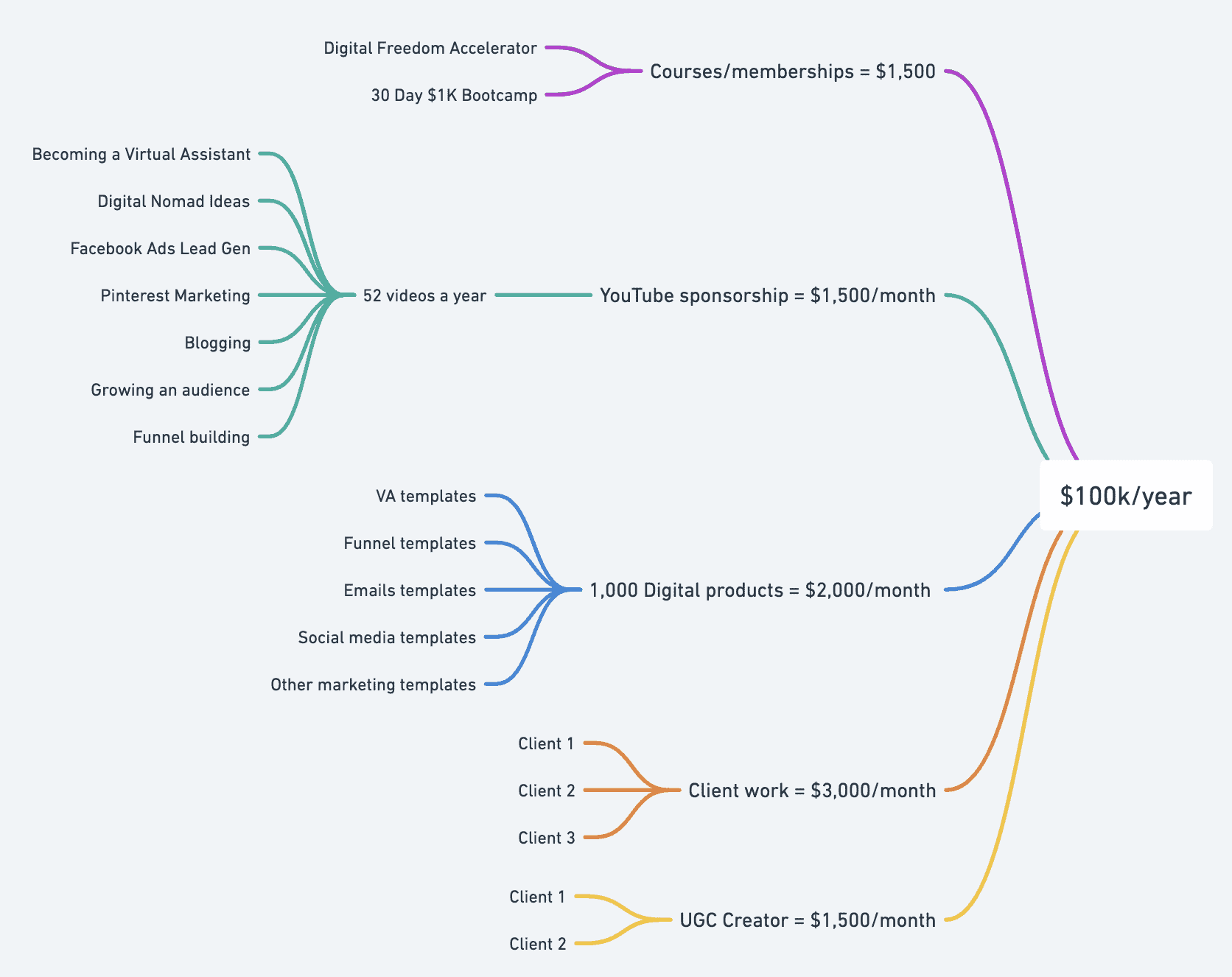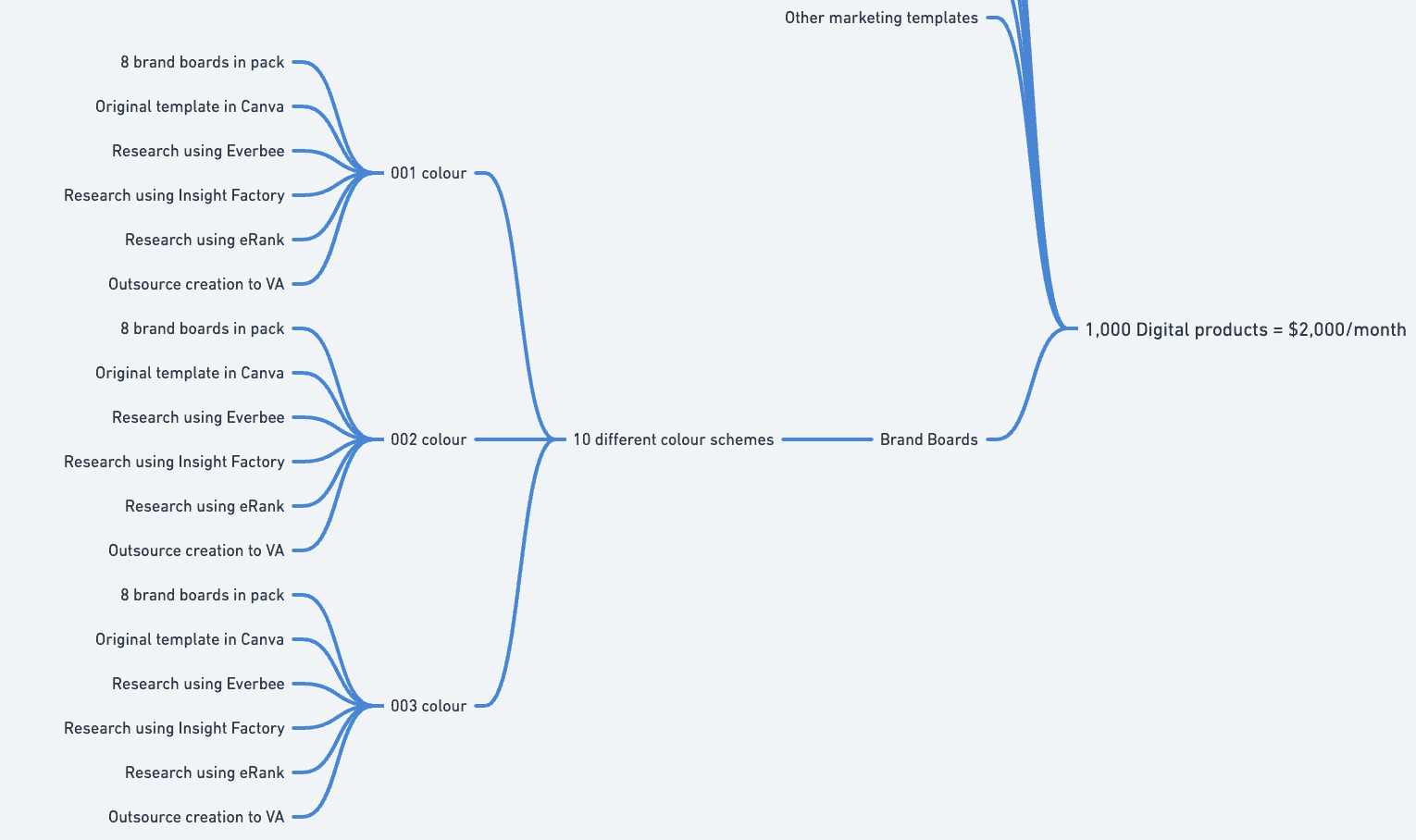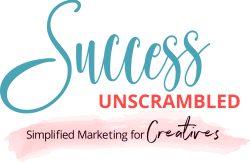Podcast: Play in new window | Download (Duration: 39:10 — 54.4MB) | Embed
Subscribe: Spotify | Amazon Music | Email | TuneIn | Deezer | RSS | More
Stacy wanted this year to be different but she needed help with her goal-setting exercises.
After looking at what she managed to accomplish over the last 12 months she knew that something needed to change.
Some weeks over the last financial year were downright hairy because of the limited amount of cash flow.
Plus her dream of living on a tropical island for 6 months of the year hasn’t materialised just yet.
If you can relate to Stacy let me know if these points sound familiar.
- Setting goals and achieving them can be quite daunting
- You’ve rarely ever accomplished the goals that you set in the specific timeframe
- Others seem to be better at setting goals but it doesn’t work for you
- You have a goal but you are clueless about the steps needed to take action
Wouldn’t it be lovely if there was a realistic way to set achievable goals with action steps as well?
In this resource, you’ll discover a few key secrets that separate the winners from the others.
Join me as we look at a few goal-setting exercises for complete beginners.

The Goal-Setting Process
Before looking at the various goal-setting exercises available for you to use.
It is important to understand the various aspects of the goal-setting process.
Many people make the mistake of looking at the ultimate goal while ignoring the reasons behind that goal.
For example, if you have professional goals like getting a 6-figure deal or having an income of $10k/month why do you need that money?
I’ll tell you why…
It’s because you have a number of personal goals behind those specific goals.
This could range from larger goals like buying a mansion or a sports car to smaller goals like hiring a fitness coach.
At the end of the day, the goal-setting process should start with the realistic goals of improving the quality of your life and the lives of your loved ones.
It’s important that you have a process that walks through the stages by adopting the 7 whys principle. At each stage of the process ask yourself why you want that thing.
Here’s what that looks like…
- I want to make $100K a year so that I can
- Pay for living expenses so that I can
- Buy a beautiful home so that I can
- Provide a secure life for me and my family so that I can
- Not have to worry about emergencies so I can
- Live my perfect day so that I can
- Do the things I enjoy
Of course, you can also do this powerful exercise in reverse order.
The most important step is that your focus is on accomplishing the right goal to create a life worth living.
Also, these must be meaningful goals for your future self so that you’ll be motivated sufficiently to accomplish them.
1. Your Perfect Day
A number of years ago I was encouraged to write out in detail what my perfect day will look like.
At the time, I was not a digital nomad or even a virtual assistant.
In fact, I thought that it was a lot of wishful thinking.
With a bit of hesitation, I sat down with a pen and a few sheets of paper.
I scribbled down my perfect day from the time I woke up until the time I went to bed.
Here are a few things I included.
- The ideal time for me to wake up each morning
- Who I would like to wake up with in my bed
- What I did after waking up
- The atmosphere and location I’d like to wake up in
- Items that I would include on the menu for breakfast
- At what time would I check messages and emails
- What I would do for work
- My working hours and days of the week
- Extracurricular activities
- Things I would like to do with my loved ones
- My downtime routine
- What I do at bedtime
- Things I do during the day for self-improvement
Although I can’t remember every single thing that I wrote down many years ago, I can tell you that this stuff works.
It’s crazy what happens when you get crystal clear about what you want to include or even exclude from your perfect day.
I’m living some of that dream even today which really amazes me because I really believed that it wasn’t possible to have a perfect day.
2. Vision Boards
Have you ever wondered if creating a vision board will work for you?
I always thought that they were useless until I discovered a dirty little secret.
You must always use photos of actual places, locations, fun experiences and things that you want in your life.
For example, a number of years ago I wanted to get my hands on the Chanel No. 5 perfume.
It looked good in the adverts so maybe it will be good for me too.
To tell you the truth I never walked up to the beauty counter and did a scent test, I just decided to get it.
That bottle of perfume remains on my bathroom shelf many years later because it doesn’t match my body scent.
The most important thing to learn from this lesson is to get crystal clear about what you include on your vision board.
Do a test drive, trial or just try it for a few days because chances are you may not like it.
When next you are creating a vision board get photos of places, things and experiences that you know would work for you.
No more magazine clippings, go try out that mattress, the sofa, the dream destination, etc.
If you like it, include it, if not, move on. Vision boards only work when you get real with your dreams.
3. Mind Mapping
One of my absolute favourite goal-setting exercises is mind mapping.
At first, I just didn’t get what the excitement was about but then one day I came across a great tool called Xmind.
My life changed forever.
Something just clicked and there I was mapping out world domination before sunset.
In case you’ve never done any kind of mind mapping before it’s like writing down your big dream and working backwards to figure out the next steps.
Here’s an example of how it works.
Say you would like to achieve an income of €100K a year. Just look at that number it may seem impossible but let’s break it down.
$100K/year = $8,333/month
What can you do to make $8,333/month?
You can do a split of 3-4 income streams like $2,000 from digital products, $3,000 from client work, $2,000 from UGC and $1,500 from sponsored content.
I have to warn you that the items that you include in the income streams must align with those things on your vision board and your perfect day.
There’s no point in you generating income from things you absolutely dislike.
Mind Mapping Visual Example
Now that you have an idea of what you want to include in a mind-mapping exercise.
Let’s do a practical example.
My favourite free powerful tool that I like to use is one called Whimsical because it’s so easy to use and you can share your mind map with team members.
Always start at the end goal and work your way backwards through the process of achieving that goal.
Here’s a screenshot of the first stages of my mind-mapping process.

Let me explain some reasoning behind why I chose these vehicles for my income streams.
I know that I only have 24 hours in one day so I’ll need some sources of income to be passive and others will need my time and attention.
I’ll also need help creating quite a number of deliverables.
Notice that under the section for digital products, I’ll need to create 1,000 different products for my store.
I already know that I can outsource the product creation process.
Using this method gives me tons of fun accomplishing items.
4. Bucket Lists
One of my favourite and fun goal-setting exercises is the bucket list.
The reason why it’s so much fun is because I use it to cover all 8 areas in the Wheel of Life.
So, it goes beyond entrepreneurial goals.
I’ve used it to cover areas like self-growth, romance, travel, learning a new language, learning a new instrument and volunteering for charity.
If you are one of my regular readers or listeners then you would be familiar with my bucket list.
However, if you’re new you can check out my 50th birthday bucket list here.
I created it before the global health crisis so that slowed my progress significantly.
However, I’m so happy to report that I’ve achieved quite a number of the items on that list which is so very exciting.
At this point, you’re probably wondering how many goal-setting exercises you’ll need to achieve your goals.
The answer, my dear, is only one.
I’m giving you a peek behind the scenes of the ones I’ve tried and what I liked or found exciting about each one.
I am also letting you know the dirty little secrets about how to get them to work for you.😉
Notice how each exercise is different in its own way.

Action Plan
Now we are at the point of setting goals where quite a number of people get lost.
This brings me nicely to a famous quote by Greg Reid.
“A dream written down with a date becomes a goal. A goal broken down into steps becomes a plan. A plan backed by action makes your dreams come true.”
Greg Reid
In order for any goal-setting exercise to work we need to ensure that those goals have a plan with steps so that we can take daily consistent action.
This is probably the most scary part of the process.
I remember the time when I had a goal but I had no idea the steps that I needed to take to make that goal a reality.
Sometimes that goal can seem insurmountable when you realise that it can potentially take you 5 years instead of 12 months to obtain results.
Let me give you an example, 10 years ago I knew what a funnel was but I had no idea how to build a high-converting funnel.
In fact, the cost back then was prohibitive.
However, slowly but surely I started that journey into learning about the tech and marketing aspects of creating gorgeous funnels.
I was curious, I was determined and I put in the work.
Now, I can build them in my sleep and I know which platforms are the best to get specific results.
Action Plan Visual Example
As I already mentioned mapping out the steps so that they can be actioned is probably the biggest hurdle for many people.
This is why I don’t want to leave you hanging by not sharing a practical example of effective goal-setting activities.
If you remember I’m using Whimsical to create a mind map of my $100K/year journey.
Let’s dive deeper into one of the areas on the map.
The area I’ll dive into is creating digital products for Shopify and Etsy.
We’ll look at the action steps needed to create one finished product that’s ready to go live.
In this example, we’re looking at creating a pack of 8 brand boards that align with a specific theme like summer or watercolour or something similar.

Notice that the 6 tasks I need to do to take the product from concept to a completed, ready-to-ship version include the following:
- Choosing a theme
- Ensuring that the original template is in Canva
- Do research in Everbee
- Further research in Insight Factory
- More research using eRank
- Outsource the creation to a virtual assistant
Of course, I’ll need to break each step further by giving objectives and dates for each step.
These dates and subtasks can then be transferred into a project management tool like Asana or ClickUp.
However, you can see how comprehensive mind mapping can be.
5. SMART Goals
One of the most popular goal-setting exercises on the planet is the concept of a SMART goal.
What’s unique about the methodology is that it is based on key performance indicators (KPIs) by breaking down important goals into manageable steps or milestones.
The word SMART is an acronym for 5 words used to set long-term goals.
Here’s how it goes…
- S – Specific
- M – Measurable
- A – Attainable
- R – Relevant
- T – Timebound
In many ways, you can see why using this methodology to set goals can be tangible.
Let’s break down the SMART acronym even further using our real-life example of attaining $100K/year.
Specific
So, we’ve broken down the goal to a monthly figure and added the vehicles (digital products, client work, etc.) we’ll be using to attain the end goal.
What we haven’t done is to break those monthly figures down even further.
Let’s look at the example of being a UGC Creator with two clients per month with an income of $1,500. What does that look like in reality?
On average clients would pay between $200 and $300 for a UGC video, so let’s assume an average of $250/video.
In order to make $1,500 with two clients I’ll need to create 6 videos a month which can be 3 videos per client.
How will I find these clients? Let’s say I do a combination of 50 outbound and inbound marketing activities to land 2-3 clients a month.
So, my specific goal will look something like this…
Acquire UGC clients every month by doing a combination of inbound and outbound activities in my chosen niche.
Measurable
When we add the measurable element to the mix it means that we need to add numbers to the specific goal.
As I already mentioned, it will take about 50 marketing activities in order to acquire these clients.
If you are like me and you only work 4 days a week that will equate to 16 days for marketing activities.
This means that I can apply and/or send pitches to 4 brands a day so that I can reach my client acquisition goals.
So, my measurable goal will look like this…
Acquire 2-3 UGC clients every month by pitching 4 brands a day on Instagram and UGC platforms in my chosen niche to create 6 videos a month.
Attainable
I look at the attainable part of this exercise as a way to do a reality check. I’m basically asking myself can I really do this?
If I have never pitched a single brand before can I really develop the habit of pitching 4 a day?
Am I better off pitching 10 a day for 5 days so that I can have free time to create videos?
As a reminder, I’m also working on other income sources in my business like client work, digital products, YouTube videos, etc.
I think it might make more sense to pitch 50 brands over a 5-day period which will free up my time to do other revenue-generating activities. Think of it as a 5-day challenge every month.
So, my attainable goal will look something like this…
Acquire 2-3 UGC clients by pitching 50 brands over a 5-day period (10 pitches a day) every month using Instagram and UGC platforms in my chosen niche to create 6 videos a month.
Relevant
This is what I like to call a second reality check because it is now asking me why am I doing this in the first place.
It is another way of saying, “Remember why you started”.
The reason why we are doing this is to achieve the BIG goal of $100K/year. This SMART goal is only one of the 5 income sources that we looked at previously.
It will bring in $1,500 a month which contributes to the $8,333/month goal. We should include this in the SMART goal statement so that we don’t forget.
So my relevant goal will look like this…
Acquire 2-3 UGC clients every month by pitching 50 brands over a 5-day period (10 pitches a day) on Instagram and UGC platforms in my chosen niche to create 6 videos a month. Done right this activity will generate $1,500 every month which will help me get to my monthly goal of $8,333.00. It is feasible because brands constantly need fresh, authentic content for their social media campaigns.
By the way, this can also be used for short-term goals as well.

Time-bound
Of course, the most important part of this goal-setting exercise is adding the boundary of time.
When would I or you want to achieve this goal of $8,333/month? This month? At some distant date in the future?
If we don’t have any dates or deadlines then this entire exercise would more or less remain like a master plan on a piece of paper or inside a virtual document that never gets activated.
It would be very similar to a dream that never comes true because we didn’t take action.
Let’s be honest, the scariest part of setting a goal is adding a date.
When we put a date on it then we suddenly break out in sweat and our armpits get uncomfortable.
Nevertheless, it has to be done if we want the results.
So, my time-bound goal will look something like this…
Acquire 2-3 UGC clients every month by pitching 50 brands over a 5-day period (10 pitches a day) on Instagram and UGC platforms in my chosen niche to create 6 videos a month. Done right this activity will generate $1,500 every month which will help me get to my monthly goal of $8,333.00. It is feasible because brands constantly need fresh, authentic content for their social media campaigns. I will start my first day of pitching brands on __/__/__, so that I can get to my first $1,500/month by the end of ___________/_____.
As you can see the ultimate goal is to have a fully comprehensive statement about that single goal to ensure that it is actionable.
Goal-Setting Exercises FAQ
Let’s look at a number of frequently asked questions around goal-setting exercises.
1. What is the first step of goal setting?
The first step of goal setting is to get a clear understanding of why this goal is important to you personally. Look specifically at both your internal and external desires.
Also, perform the 7 Whys methodology to get to a deeper level of your motivation for setting a goal.
2. What are 5 SMART goals?
The 5 SMART goals include the following:
- S – Specific
- M – Measurable
- A – Attainable
- R – Relevant
- T – Timebound
See a comprehensive breakdown included in this post above.
3. Why must entrepreneurs set goals that are SMART?
I’m going to be a little controversial and say that setting goals that are SMART is not necessarily a must but it does help by associating key performance indicators (KPIs) to determine success.
In other words, by taking these specific actions consistently you’ll increase your chances of achieving your business goals.
4. What is the most important goal of an entrepreneur?
To generate sufficient income to maintain a healthy cash flow and keep your business viable.
Summary
Goal-setting exercises can be difficult and scary however life can be disappointing when you fail to achieve your goals.
Even when you set new goals the next year but still fall short of getting the results you wanted.
I’m intrinsically motivated so I wake up every day excited to get stuff done.
I know that this is not the same experience for everyone because each of us gets motivated in different ways.
Developing new habits in several areas of your life also gives you a new sense of purpose.
Sometimes writing a letter to your younger self can be used as a wake-up call to help you get clarity on your future.
Many years ago I felt stuck because I would set goals in a wishy-washy fashion.
At the time I didn’t know the necessary steps I needed to take to achieve my goals.
Today, my life is so different and I feel like a veil has been lifted. The truth is that a veil hasn’t been suddenly lifted.
In fact, I’ve learned a ton of new skills and strategies that I’ve used to earn my first $100,000 online as a virtual assistant and you can do the same too.
If you would like to learn how to make $3k/month as a virtual assistant then grab this resource.

